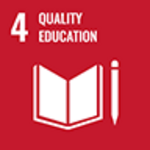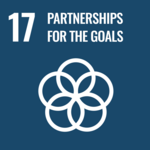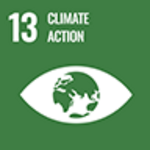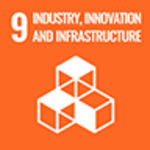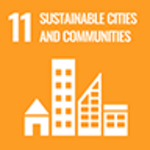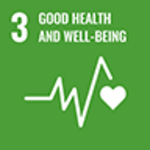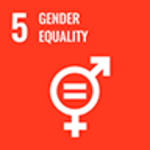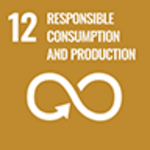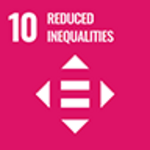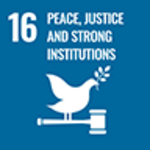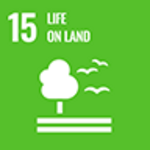
Demura: Hokkaido University will continue to be a university that contributes to the creation of a sustainable society even after 2030, which is the goal of the SDGs. For those of us living today, the SDGs are like a universal textbook compiled by the United Nations regarding the issues that need to be resolved by 2030. It is none other than us, the people who will live in the future, who will use this textbook to figure out how to envision and realize a sustainable future society.

Professor Makoto Demura
Professor Makoto Demura is a life scientist who studies the structure of proteins that support life activities, and is also a leader in promoting SDGs activities at Hokkaido University. We asked the professor, who is also the initiator of the creation of the website "Hokkaido University x SDGs," about what he plans to communicate about the relationship between Hokkaido University's education and research and SDGs initiatives.
Classifying Hokkaido University's education and research from the perspective of SDGs
Please tell us about Hokkaido University's SDGs initiatives.
Demura: In August 2021, we launched a new organization called Institute for the Advancement of Sustainability. We are currently preparing to communicate the organization's policies and Hokkaido University's activities in an easy-to-understand manner to everyone inside and outside the university.
During the preparation stage, we ask faculty members within the university to reflect on how the education and research they are involved in is related to solving SDGs issues from an SDGs perspective. What we realized was that Hokkaido University has a solid foundation for working on the SDGs.
Hokkaido University will soon celebrate its 150th anniversary in 2026. Long before the term SDGs appeared, since the days of Sapporo Agricultural College (opened in 1876), which began as a learning center for agriculture, forestry, and livestock industries that are directly connected to the environment and human activities, we have been contributing to the creation of a sustainable society.

An important cultural property model barn (model livestock barn, granary, and cattle shed) remains to the north of the Sapporo campus. He learned the latest livestock farming styles from Europe and America, improved them for the livestock industry in the cold region of Hokkaido, and trained many instructors. (Constructed between 1877 and 1879, relocated and renovated in 1910)
Sustainability spirit rooted in a campus rich in nature
When did Hokkaido University begin efforts to promote sustainability?
Demura: It all began over 25 years ago, in 1996, when a national university formulated its first `` Campus Master Plan.'' In 2005, we established the Sustainable Development International Strategy Headquarters, which has been running projects such as Sustainability Weeks for 10 years. In 2008, in conjunction with the G8 Hokkaido Toyako Summit, our university held the world's first G8 University Summit in Sapporo as the vice-chair university, with the aim of clarifying the role of universities in sustainability. “Sustainability Declaration” was adopted. In 2014, “Near Future Strategy 150” was formulated. The SDGs were adopted by the United Nations in 2015, so you can see that Hokkaido University has been at the forefront of the world in promoting sustainability for about 20 years.
2020: 1st place in Japan in THE World University Impact Ranking (76th overall ranking, top 10% in the world); 2021: 1st place in Japan in THE World University Impact Ranking (within 200 overall rankings; Tohoku, Tsukuba, Tokyo, It is highly regarded around the world, on par with Kyoto, Okayama, and Hiroshima universities). In order to inherit and advance this trend, Hokkaido University intends to further instill "sustainability" in education, research, and university management.

Was Mr. Demura also centrally involved from the beginning?
Demura: In the liberal arts class I taught for first-year students, ``The World of Science and Technology (First Time in Life Science),'' we actively talked about sustainability and SDGs, but Hokkaido University as a whole was not at the center of the effort. In the class, we give examples of biomimicry (biological imitation technology), which is used in the process of creating things that artificially reproduce the shapes and functions of living things to help reduce environmental impact. I'm talking about thinking holistically to see if energy and emitted substances are a burden on the environment. We also have group discussions with students and ask them to think about the relationship between environmental impact and technological innovation. This class has been going on for almost 10 years, and I decided to include the SDGs as a topic halfway through the class.
I started being involved in Hokkaido University-wide initiatives around 2018. Considering that students will go out into society and face various challenges, I began to feel the need to educate Hokkaido University from an SDGs perspective. In 2018, the new curriculum guidelines were just revised, and it became clear that future elementary, junior high, and high school students will be educated to become creators of a sustainable society, and it is easy to imagine that someday university students will enroll who have learned about the SDGs. I did. Therefore, I reached out to the teachers around me, set up a working group, and started in 2020 to let people know about Hokkaido University's educational content, which is rich in the sustainability spirit rooted in a campus rich in nature, from the perspective of the SDGs. This led to the launch of the website `` Hokkaido University x SDGs''.
I see that you have inherited the sustainability activities that Hokkaido University has continued to carry out.
Demura: As we launch the new Institute for the Advancement of Sustainability, we are once again realizing the importance of the foundation we have built since 1996. The first thing that struck me was the existence of Hokkaido University's campus, which is equipped with functions and facilities for education and research, while being surrounded by a rich natural environment. We have a comprehensive educational environment that includes not only the Sapporo campus, but also the Hakodate campus, a field area approximately 1/500th the size of Japan, a marine research base, and a training ship, which is why we have 12 faculties and 21 graduate schools. It is no exaggeration to say that we are able to carry out innovative education and research.
First of all, we believe it is important to manage and operate this school building sustainably, so we created an organization called Sustainable Campus Management Office (SCM Headquarters), which was established in 2010 and reorganized in 2018. Currently, the SCM Headquarters is conducting advanced activities in collaboration with universities in Japan and overseas that are undertaking similar initiatives, in order to promote energy conservation and decarbonization activities across the campus. This "SCM Headquarters" and the newly established "SDGs Initiative Office" will be the two wheels of the "Institute for the Advancement of Sustainability" that was launched in August 2021.
A one-stop point of contact connecting Hokkaido University and other areas
What kind of organization will the newly established "SDGs Initiative Office" have?
Demura: The SCM Headquarters is responsible for campus management, focusing on campus facilities and equipment, while SDGs Initiative Office is responsible for education, research, and social collaboration. The first thing I would like to do is open a one-stop counter. It is a point of contact where people can say, ``If you come here, you can learn everything about Hokkaido University related to the SDGs.'' In particular, we would like to introduce and publicize Hokkaido University's research from the perspective of SDG17, and work with the SCM Headquarters to expand partnerships with companies and governments.
Some researchers are already working on SDGs activities in cooperation with Hokkaido and Sapporo City, and I would like to see them further expand into regional collaborations, collaborations between domestic universities, and international collaborations. We also plan to provide public lectures and lifelong education for high school students and working adults.

Providing the best educational environment for SDGs native students
So the window is opening wide to the inside and outside of Hokkaido University?
Demura: A university needs to be a place of learning that is open to society in its own time. This is because, while universities are places to explore cutting-edge knowledge, they also have a responsibility to develop human resources who can return that knowledge to society.
The students who will be entering our school from now on are SDGs natives, meaning they have been exposed to SDGs topics and activities since elementary, middle, and high school. Since such a generation is coming to Hokkaido University, we want to prepare a good learning environment and provide them with an education that will enable them to become creators of a sustainable society even after they graduate. I believe this will be a major pillar in formulating the policies of Institute for the Advancement of Sustainability.
How will Hokkaido University's education change in the future?
Demura: In addition to adding new education and research related to the SDGs, Hokkaido University has sufficient ``Sustainability'' potential by simply reclassifying the educational curricula and research themes that already exist in its 12 faculties and 21 graduate schools from the perspective of the SDGs. (Hokkaido University x SDGs) will introduce you to the SDGs initiatives of all 12 faculties and 21 graduate schools, not limited to liberal arts, science, basics, and applied sciences. ). For example, universities have an online curriculum database called the syllabus, and more than 10,000 courses are published every year. Just a keyword search for the SDGs will reveal about 400 classes. Furthermore, a keyword search related to SDGs issues such as food production, water shortages, health and the environment, plastics, and energy reveals that Hokkaido University offers a considerable number of curricula. We are thinking of changing the curriculum list to make it easier to take "Sustainability Education," which is classified as an SDG. Additionally, we are considering radically updating ``career education'' and ``sustainability education,'' which will be particularly important in future learning, from undergraduate to graduate school master's and doctoral programs, but major system changes will take several years. It takes a unit of time, so it seems like it will still take some time.

Schools are becoming more and more conscious of SDGs and social issues.
Demura: The recent successes of our students show that they are facing social issues and actively learning what they want to learn. Examples include the Hult Prize (*1) and Jikatagaku *2. In addition to learning specialized curriculum, it is also important to interact across faculties and departments, and to be exposed to a variety of cross-disciplinary learning and ways of thinking. Nitobe College, a special education program, strives to develop human resources who can demonstrate leadership and contribute to solving the world's problems. We would like to spread the word about these Hokkaido University-wide initiatives to a wider range of students.
On the other hand, I believe that it is not a good idea for us teachers to arrange the activities of the students from beginning to end, and that there are many things that can be gained by working independently and developing them, sometimes with great difficulty. I hope that it will be an important experience for you. What we can do is sow the seeds for students to develop themselves. I would like to create an educational environment where students can take on challenges at any time. “Together we create a sustainable future” through the partnership of students, faculty, staff, and society. The title of the website “Hokkaido University x SDGs” reflects this idea!
*1 Hult Prize: The world's largest student business idea competition sponsored by the Hult Prize Foundation. A theme related to the United Nations' SDGs is set every year, and students from all over the world compete to come up with business ideas, with the winning team receiving $1 million in corporate funding.
*2 Regional studies: Inazo Nitobe, a second-year student at Sapporo Agricultural College, preached and advocated that Practical Learning is nothing but an emphasis on the field (region). This is a practical support program for graduate students that focuses on Hokkaido, an area where various social issues are becoming more serious than the rest of the country.
I was really looking forward to seeing Hokkaido University contribute more and more to SDGs and sustainability. Thank you very much, Mr. Demura.
[Planning/Production]
Hokkaido University URA Station / SDGs Initiative Office (Planning)
Space Time Co., Ltd. Keiko Nakamura (Director/Editing/Writing) Kyohei Hosoya (Writing)
PRAG Kenta Nakamura (Photography)

Makoto Demura Professor
Affiliation: Hokkaido University Graduate School Faculty of Advanced Life Science Front Office for Human Resource Education and Development (concurrent post)
Life science, biophysics, polymer functionality
In addition to exploring life sciences, we are modeling lessons on changing ways of thinking and collaborative thinking that will lead to reducing environmental impact, such as biomimicry. We want students who grew up at Hokkaido University to become active players in the world as creators of a sustainable society.

















